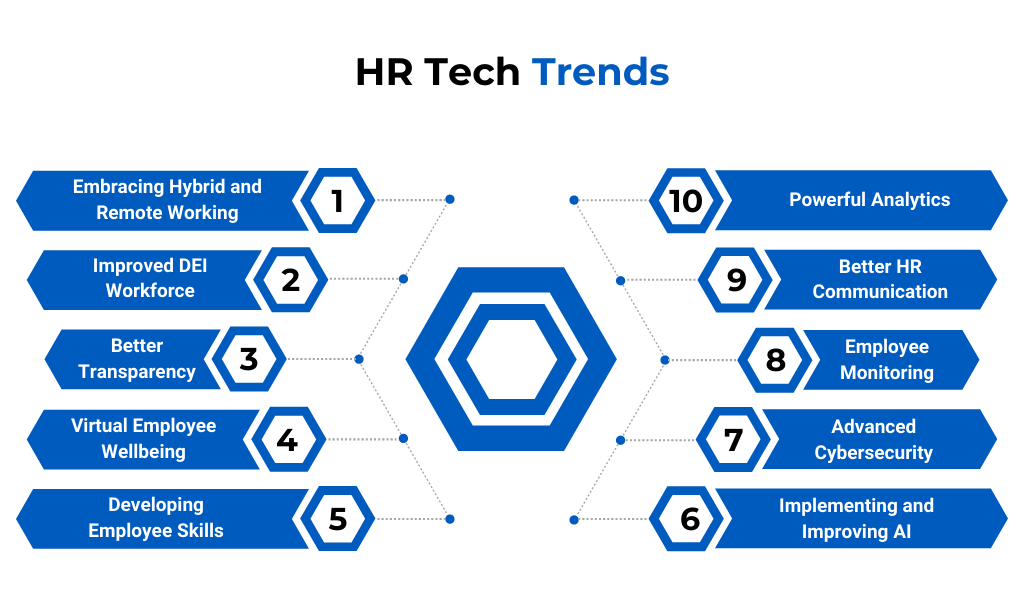The last 2 years have not been kind to HR, to put it mildly. Since the beginning of the pandemic in 2020, HR has been trying to make effective use of the HR technology under their disposal to ensure that the employees are staying engaged with their company.
From 2021, the HR tech trends have been to develop new technologies to help ease the burden on HR. We saw the rise of AI in HR domain as well as the improved productivity that came with it.
Hence, we have curated a list of HR trends 2024, that would help you take the right steps to get your employee satisfaction index to shoot through the roof!

1. Embracing Hybrid & Remote Working
Since the world has moved towards hybrid and remote working environments, HR technology is also moving in the same direction. The latest HRMS is utilizing various remote working functionalities to serve the HR in undertaking their tasks remotely, while also helping the employees remain productive.
With over 50% of employees wishing to continue working remotely, HR is aware of the fact that remote and hybrid work is here to stay. Hence, HRs are embracing the technology that would help remotely manage their employees and help them stay engaged with their company.
2. Improved DEI Workforce
As the workforce starts going down the remote route, diversity, equity and inclusion take on a different dimension altogether. With remote work, you are no longer restrained to working with the talent found locally. You can find talented individuals throughout the world and interest them in working for you by using the correct language.
Here, HR technology once again becomes a major ‘enabler’ by helping HR cross boundaries to find and recruit talented employees without any bias. Having such a diverse team not only improves the work culture of the company but also helps in bringing the diverse viewpoints and perspectives of these individuals from different backgrounds.
3. Better Transparency
HRMS systems ensure transparency by helping with 360-degree feedback, 1-on-1 meetings, customized performance evaluations, etc. This helps the employees understand their value in the company and take necessary steps to improve themselves. It also helps them understand the company values better and align their work ethic with it to better fit in the company.
Due to these changes, the employees would feel motivated and cultivate a sense of belonging to the company and the team. They would also better understand their accountability towards their contributions and hence, undertake their tasks better. All of this helps a lot in ensuring the company’s success.
4. Virtual Employee Wellbeing
Owing to the pandemic, employee wellbeing has come to the forefront. As a direct result of this, HRs either started new employee wellbeing initiatives or reinforced the efforts put into it. However, providing well-being services would be impossible without remote working technologies.
There are dedicated applications developed to help remote employees with their mental wellbeing. Even AI is being employed in this domain as some individuals find it easier to open up to a bot than a human being. All of these efforts are put into employee wellbeing as the HR and managers have realized that it has a direct effect on the employee’s productivity and engagement.
5. Developing Employee Skills
Upskilling and cross-skilling are going to be a huge HR trend in 2024. Hence, HRs need to be provided with all the help they can get, for supporting them in this endeavour. Mobile learning is the key buzzword here, and upskilling can be accomplished with the help of microlearning. Additionally, gamification can be used to make learning fun along with the usage of VR and AR technologies to supplement it.
Since closing the generational gap is also going to be a priority in 2024, most of it is going to revolve around developing the older generation’s digital skillset. All of these efforts would lead to a visible transformation in the workforce that would become the hallmark of a successful company in the future. The HR teams would themselves undergo major transformation by embracing digitization and implementing assistive software and technologies in their domain.
6. Implementing & Improving AI
AI has already taken the HR domain by storm. It has improved data-based decision making in 62% of the companies where it was deployed. According to a Gartner study conducted in May 2020, 17% of companies already use AI-based solutions to improve their HR functionalities significantly, while an additional 30% are planning to deploy AI in HR by 2024.
All of these statistics point to one thing: AI in HR is here to stay and become even stronger in its assigned roles and responsibilities. Companies are already employing AI to improve their HR operations such as recruitment, employee engagement, performance management, etc.
However, AI would soon have an active role in ‘non-traditional’ modules such as employee training, workforce management, skills management, etc. Since the AI-based HRMS platforms are on the rise, it would also mean that the AI would become more efficient in performing its duties due to its additional usage.
7. Advanced Cybersecurity
With the advancement of AI and remote working, data security has become a viable concern for HR and management. As per an IBM study conducted in the US, the costs incurred due to data breaches in companies amounted to 4.24 million dollars in 2021. Remote work and the lack of cybersecurity awareness was poised as the major factors contributing to this huge figure.
As remote and hybrid work is here to stay, HR would be required to work in tandem with the IT department to draft a set of new remote working employees. They would also be required to conduct cybersecurity training and even convince the management about the usefulness of the same.
They would also be required to play an active role in planning a response to cyber-attacks. All of these cybersecurity-related factors need to be considered while deploying the IT security infrastructure and policies of the organization.
8. Employee Monitoring
Although monitoring employee productivity has given rise to some controversies regarding employee privacy, it has been heralded as the next step in improving the overall productivity of the company.
With the rising popularity of remote working, employee monitoring technologies are again in the limelight. These applications can be used to monitor the employees with the support of time tracking, software usage, internet usage, random screengrabs, etc.
On the other hand, companies are regularly taking feedback from their employees to understand their hardships and improve their processes and daily work, as well as improve their overall experience with the company.
This data can be used creatively to track productive habits and avoid burnout. It can also be analysed to develop soft skills training for the employees.
9. Better HR Communication
Since remote working hurts employee communication and collaboration, HR technology has stepped in to be a communication enabler. A recent survey has already established that 60% of remote employees are actively collaborating on given tasks, while 77% of on-site employees can collaborate effectively.
Hence, it is up to HR to develop the required circumstances to communicate and collaborate effectively. Technology can be used to interact with virtual teams who are geologically apart yet working on the same project. Similarly, with the help of HR technology, one can also let gig-workers collaborate with the permanent employees to ensure that then projects are completed on time.
10. Powerful Analytics
The digitization of HR has also resulted in the rise of powerful analytics and reporting tools. In fact, with the help of AI, predictive analysis can be conducted which help in predicting employee behaviour based on historical patterns.
Based on these patterns, HR can take necessary actions to correct the course of the company. For example, if there seems to be a rising trend of resignation among the employees recently, you can analyse it with the help of AI-enabled HRMS and take necessary steps to curb the turnover.
Having access to powerful analytical tools also helps HR allocate adequate resources for specific tasks. With the help of big data analysis and automation, HR would be able to manage employee engagement with improved efficiency as they would be able to get suggestions from the software itself to improve the overall company efficiency.
Conclusion
Whatever the future holds for HR, it is a fact that it will include the application of HR in some form or another. Hence, these are the ten HR trends that we believe would be huge in 2024.
HR digitization has been a buzzword since the last decade and artificial intelligence is the newest tool in their arsenal to help the employees stay satisfied and engaged with their companies.
Since the pandemic has pushed the boundaries of HR beyond our wildest dreams, 2024. will be the year when we make sense of the situation handed to them to provide more value to their business.








